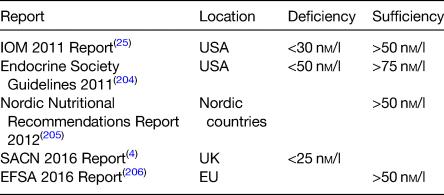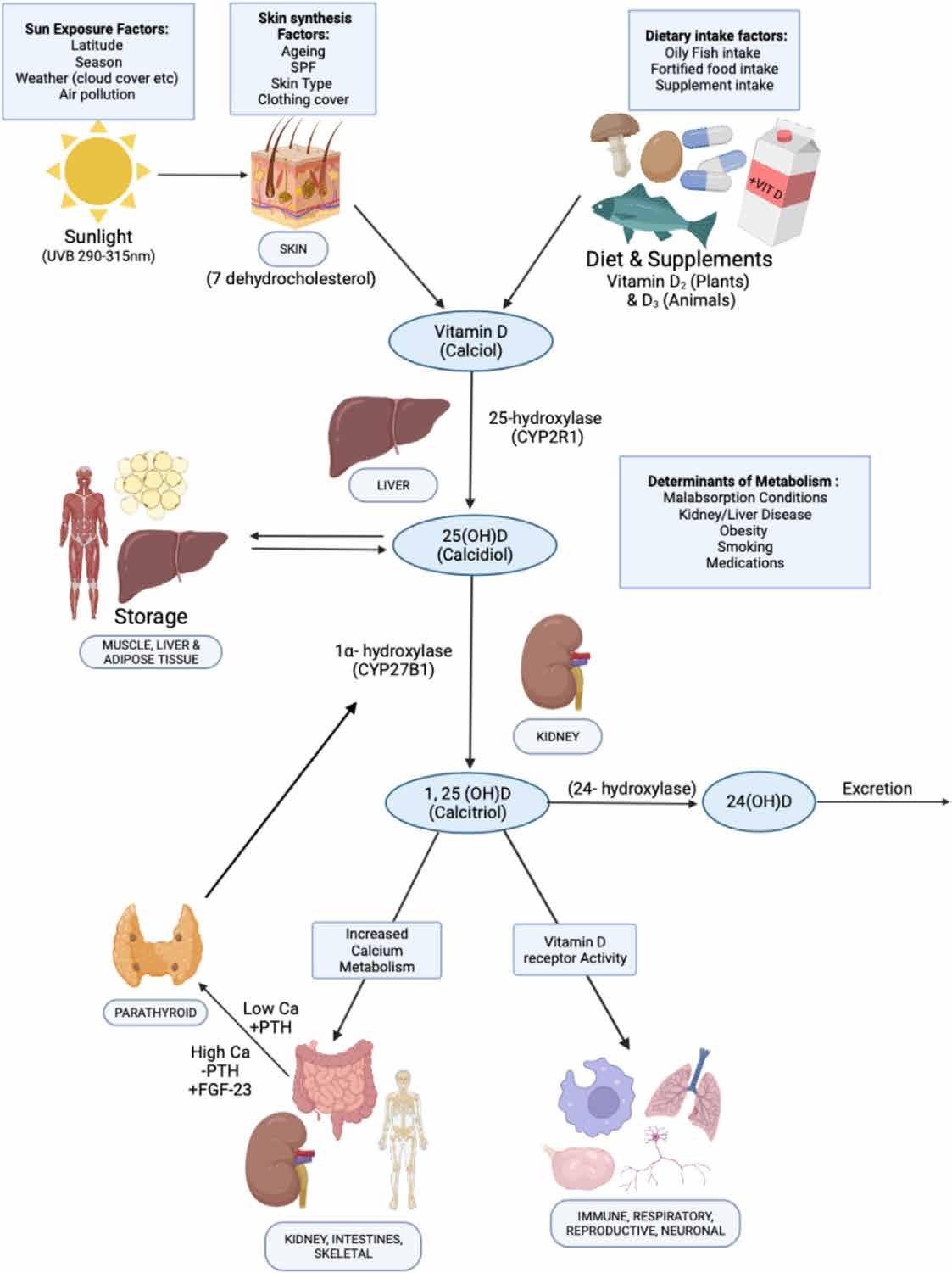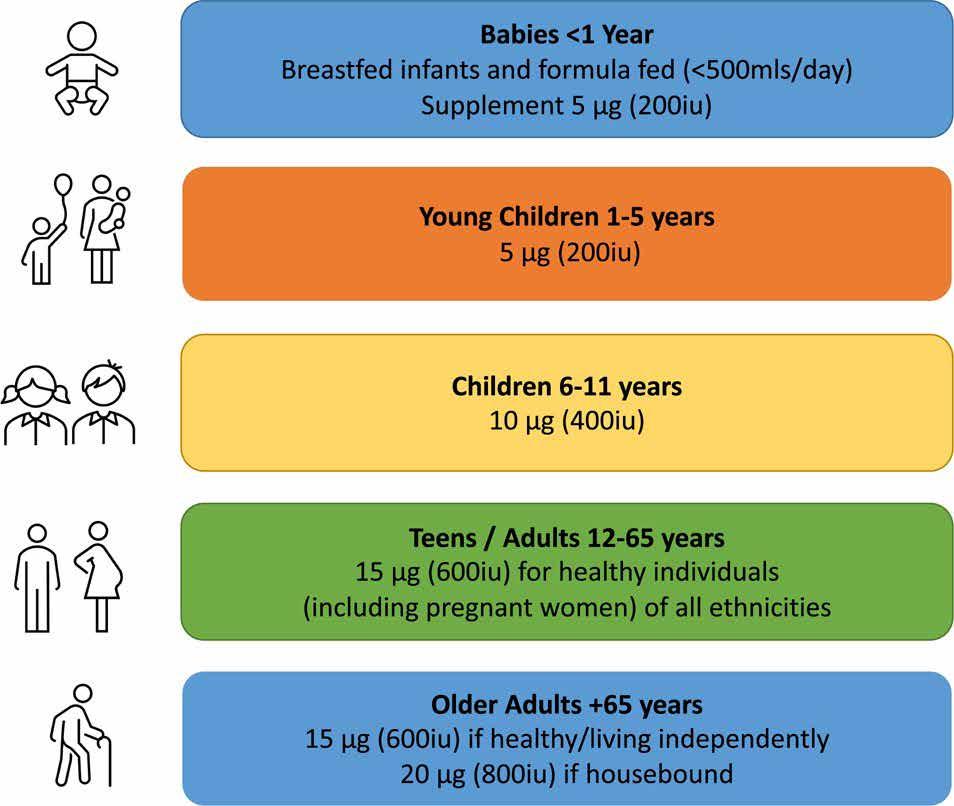
13 minute read
Vitamin D intake and status in Ireland: a narrative review part 1
Vitamin D intake and status in Ireland: a narrative review part 1

Vitamin D is crucial for musculoskeletal health, being required for the adequate absorption of calcium from the gastrointestinal tract. Vitamin D is a secosteroid synthesised via the action of UVB light on the skin, forming cholecalciferol (vitamin D3) (Figure 1).1 While this is the predominant physiological source of vitamin D, it can also be obtained from the diet in animal and plant foods (ergocalciferol or vitamin D2) and from fortified foods.2, 3 Its role in bone health is well established,4 with deficiency increasing the risk of rickets in childhood and osteomalacia in adults.1 Secondary hyperparathyroidism due to vitamin D deficiency can result in musculoskeletal pains and muscle weakness.5 Peak bone mass, which may determine up to 60 % of osteoporosis risk in later life can only be achieved with sufficient vitamin D and calcium intake.1 The role of vitamin D may also extend beyond bone health. For example, vitamin D receptors are found in numerous cells including immunological (T- and B-cells), osteoblasts, β cells and mononuclear cells, and in many organs such as the brain, heart, reproductive and the gut.6 Interaction of transcription factors [1,25-hydroxyvitamin D2 (1,25(OH)D2)] with the vitamin D receptors modulates gene expression, influencing numerous physiological functions including anti-cancer, immunological and anti-inflammatory effects.7, 8 Thus, it may be involved in the pathogenesis of hypertension, stroke and CVD and may also play a role in immunity, autoimmune diseases, type I and II diabetes, multiple sclerosis, cancer, depression and dementia.6, 8, 12 While plausible physiological mechanisms exist for these potential extra-skeletal effects, evidence from robust randomised controlled trials is limited and causality has not been established.4, 6 However, maintaining adequate vitamin D status (>50 nM/l) has been associated with decrease in allcause mortality in a recent large prospective cohort study.13
Vitamin D status is determined by a number of intrinsic, environmental and lifestyle factors. Biosynthesis of vitamin D from UVB sunlight (290–315 nm) is dependent on the correct latitude, and for countries above 40°N such as Ireland (52–55°N) this is negligible between October and March.3, 14 Cloud cover, time of day, altitude and air pollution can also affect production and give rise to regional variations in status.15 Factors including age, skin type, sunscreen use and clothing cover also determines dermal synthesis.16 Finally, the absorption and bioavailability of vitamin D is affected by malabsorption conditions (e.g. Crohn's/coeliac disease), medication, smoking and obesity.3, 17
As a result of limited sun exposure, the Irish population is dependent on dietary sources of vitamin D, though intakes remain low, and most do not meet the RDA.18 The RDA as set by the Food Safety Authority of Ireland varies by age as shown in Figure 2.19–22 In addition, the proportion at risk of deficiency is rising due to demographic andother changes.20 For example, the population is ageing, with the proportion over 65 years set to double by 205023 and there has also been an increase in those of ‘non-white’ ethnicity.24 Levels of overweight and obesity are also on the rise, increasing from 55 and 19 % in 2006 to 61 and 25 %, respectively, in 2016.23 While there are relatively few cases of rickets, the number reported has increased with twenty-three cases recently described in two Dublin hospitals.20 For these reasons, knowledge of both trends and current vitamin D status and intake is important in several subgroups of the population. There is no universal agreement on definitions of deficiency and sufficiency by professional bodies (Table 1). Vitamin D > 125 nM/l is suspected by the National Academy of Medicine as being harmful to health with potential negative effects on falls, depression and possibly other outcomes including cancer and all-cause mortality in some studies.25, 27 However, the National Academy of Medicine takes a precautionary approach that also factors in ethnic/genetic differences so as to maximise public health protection.27 Despite this, overt vitamin D toxicity causing hypercalcaemia is rare and usually occurs at levels above 375 nM/l.4, 28
Due to the limited half-life of the biologically active 1,25(OH)D (4–6 h) and its tight feedback control, vitamin D status is assessed by monitoring concentrations of 25(OH)D (half-life 3–4 weeks) which is under no feedback regulation.29 There are several types of vitamin D analytical techniques, with varying sensitivities and specifications.30 These include binding assays; RIA, chemiluminescence immunoassay, protein-binding assay, and bioanalytical assays such as HPLC and liquid chromatography tandem mass-spectrometry (LC-MS/ MS). Binding assays are relatively quick and inexpensive but are subject to interference from other vitamin D metabolites and may overestimate 25-hydroxyvitamin D [25(OH)D] concentration.29 HPLC and LC-MS/MS allows for the quantification of a large number of samples, but require more technical skill.30 LC-MS/ MS is now considered the gold standard of vitamin D assessment and allows for the measurement of both 25(OH)D2 and 25(OH)D3.29 The vitamin D standardisation programme and vitamin D external quality assessment scheme were developed to improve the accuracy and repeatability of vitamin D assessments.31, 32 Vitamin D intake is typically assessed with FFQ that include 24-h re-calls and 3–7-d food diaries. Weighed food diaries are most commonly utilised in Irish national nutrition surveys and calculate vitamin D intake using nutrient composition databases.33



To date, no study has comprehensively reviewed vitamin D research with regards to vitamin D status and intakes on the island of Ireland. We aim to summarise the peer-reviewed studies and official reports published since 2010 or earlier for specific subgroups where no other data was available. For the purpose of this review, we defined deficiency as <30 nM/l and excess as >125 nM/l unless otherwise stated.25
Vitamin D status and intake by population categories
Pregnancy and fertility
The largest Irish study (n 1768) in pregnant women found a prevalence of deficiency of 17 %(Reference Kiely, Zhang and Kinsella34), which was similar to other large studies where it ranged between 15 and 17 %.35, 36 In other studies, it varied between 13 and 65 % but sample sizes were small and were not likely to be representative.37, 40 In general, deficiency was less prevalent in early pregnancy (13–29 %)34, 36, 38, 41, 47 with rates increasing with gestation in most studies.41, 42, 45,47 A high proportion of mothers (25–65 %) were also found to be deficient at delivery.39, 40 As expected, a seasonal variation in vitamin D deficiency in pregnancy was found,34, 38, 43, 45, 48, 50 with the lowest prevalence of 3–7 % detected in summer/autumn.34, 38
The prevalence of levels <50 nM/l in the largest studies were between 42 and 44 %(Reference Kiely, Zhang and Kinsella34–Reference Hemmingway, Kenny and Malvisi36), while in smaller studies variance was pronounced (44–91 %)(Reference O'Callaghan, Hennessy and Hull38,Reference Onwuneme, Martin and McCarthy40) . A seasonal effect was also evident, with prevalence generally higher in winter v. summer(Reference Kiely, Zhang and Kinsella34,Reference O'Callaghan, Hennessy and Hull38,Reference O'Brien, O'Sullivan and Kilbane45,Reference Holmes, Barnes and Alexander48) . Prevalence of levels below <50 nM/l is similar to some pregnancy studies in Northern Europe where it affected approximately 50 % in the UK(Reference Gale, Robinson and Harvey51) and Belgium(Reference Vandevijvere, Amsalkhir and Van Oyen52). Only one Irish study (n 138) looked at men and women undergoing fertility treatments and found that one out of five was deficient(Reference Neville, Martyn and Kilbane53).
Dietary and supplement intakes in pregnancy
Dietary intakes in pregnant women ranged between 1 9 and 10 7 μg/d,46, 54 with 80–99 % not meeting the recommendations.54, 56 By comparison, in the UK, 98–100 % were found not to meeting the advised intake of 10 μg/d.57
In Ireland the RDA in pregnancy is no different from the general adult population at 15 μg/d.22 However, evidence suggests that pregnant women require 20 μg/d to meet sufficiency (>50 nM/l)58 with 10–15 μg/d advised by a European consortium.59 In Finland, the 2003 food fortification of liquid milk resulted in a significant increase in vitamin D intakes in pregnant women,60 and as such should be considered as a public health measure to improve vitamin D status in Ireland.
Nearly 40 % of pregnant Irish women reported taking a specific vitamin D supplement in a Dublin study (n 175) in 2016, though the sample was from a confined area.61 However, when including a multivitamin containing vitamin D, 74 3 % were actually taking some form of supplementary vitamin D.61 Importantly, less supplement use in pregnancy has been associated with an increased risk of low vitamin D status in Irish infants.49 Supplementation in Irish pregnant women was also the strongest predictor of 25(OH)D > 30 nM/l with Caucasian females more likely to supplement than those of other ethnicities.37
Children/adolescents
In the largest study to date (n 5524), 15 % of children (5–19 years) were deficient,62 while the second largest (n 1226) found a deficiency rate of 23 %,63 though both were conducted in the Dublin area. In most studies deficiency prevalence varied between 5 and 23 %.62, 68 The most recent nationally representative study that measured vitamin D levels in teenagers (aged 13-18 years) found that 21.7% were deficient though sample size was small (n=246).69 The highest prevalence of deficiency (63–68 %) was reported in adolescents (aged 12 or 15 years) in Northern Ireland.70 However, vitamin D was assessed over 20 years ago, was not checked in the months of July or August and the study population was derived after stratified sampling so may not be more broadly representative. Furthermore, the results are discordant with other studies. As expected, the prevalence of deficiency was lower in the summer66, 71, 72 and higher in winter when it affected 18–30 % of teens,71, 72 and 26 % of children aged 1–17.63 In general, female children also had lower vitamin D status,63, 65, 70, 73, 74 but not in all studies.64
Notably, there was a ‘U-shaped’ relationship between deficiency prevalence and age, being lower in younger children (1–12 years) and greatest in adolescents and older children (>12 years). 62, 63, 65 For example, a recent large study found a greater prevalence of deficiency in over v. under 12s (24 v. 16 %).63 Lower rates of deficiency (2 %) have been found in toddlers (aged 2 years) and children under 5 (13 %),64, 66 with higher 25(OH)D also reported in those under v. over 4 years (61 0 v. 46 1 nM/l, P < 0 001).65 Similarly, in a recent large study, deficiency was lower (5 %) in toddlers (1–4 years) but much higher (15 4 %) in older children (5–19 years).62 Better vitamin D status in younger children (<5 years) may relate to Ireland's infant supplementation policy.75 Conversely, lower rates of supplements and fortified food consumption has also been found in Irish teens compared to younger children.76 One study also reported that older teens (15–18 years) had lower mean 25(OH)D and were more likely to be deficient than younger teens (13–15 years).69 Greater screen time/sedentary behaviour and increased obesity rates in this age group may be important factors.77, 79 Socioeconomic status may also explain some of this variation as it has been associated with a higher prevalence of deficiency in Irish children.63 Overall, reports are broadly consistent with findings in northern European countries (47–69°N).80, 83 and in the UK 19 % of 11–18-year-olds were deficient, compared to just 2 % of those aged 4–10.84
Despite in general, less deficiency in younger children, this was not apparent for those aged <1 year. For example, deficiency in new-borns was high ranging from 34 to 63 % (based on cord blood samples),35, 39, 42, 49 while in preterm infants 64 % were deficient at delivery.40
Overall, approximately half of children aged 1–17 years had levels <50 nM/l,62, 63, 65, 68, 69 with a seasonal variation identified,63, 66, 73 similar to findings in the European Union (EU).75, 80, 85 Similar to deficiency, prevalence was lower in younger children (1–5 years), at 21–39 %.62, 64, 66 and higher in teens at 36–89 % as in UK studies.81 The prevalence of 25(OH)D < 50 nM/l in new-born cord blood was particularly high (between 80 and 92 %),35, 39, 42, 49 and similar (79–92 %) in preterm and term infants.35, 40, 42, 44, 49
Dietary and supplement intakes in children
The first nationally representative dietary survey in 2010/2011 in Irish children aged 12–59 months found that 70–84 % had intakes <5 μg/d (mean of 3 2 μg/d).86 In a small study (n 97) of 5-year-olds in 2019, intake remained low with just 6 2 % having consuming above 5 μg/d.64 Recent nationally representative surveys of older children (5–12 years) and teens (13–17 years) found the majority (94 %) had intakes <10 μg/d,
with little improvement between 2003/2004 and 2017/2018.78, 87, 88 In fact, comparing surveys, intakes had improved only a little, from 2 7 to 3 7 μg/d for teens and from 2 3 to 4 2 μg/d for children.87,89–91 Similarly, in a recent nationally representative study of teenagers (aged 13-18).69
In Irish infants, milk/formula comprised of 29 % of total intakes,86 similar to that in UK children aged 12–18 months.92 Milk/products were also the greatest source of vitamin D in children <4 years in Ireland followed by meat and its products as found in the UK.86, 92 However, in Irish children aged 5–12 years, fortified cereals were the largest contributor, followed by meat and then milk products87 as also identified in Belgium and the UK.81, 93 Meat and its products also account for the primary source of vitamin D in Irish children over 13,78,94 despite its relatively low content. This is also reflected in the UK, where it comprised of 35 % of dietary vitamin D intake.4
Children aged 1–5 years in Ireland are recommended to receive 5 μg/d, supplementing if necessary, with older children (aged 6-11 years) advised to consume 10 μg/d.20, 22 Overall, supplements are an important contributor to vitamin D status in children and adolescents in Ireland,65, 95 as found elsewhere in Europe.96, 98 The most recent national dietary survey (2017/2018) of Irish children aged 5–12 years indicated that just 10 % consume a vitamin D supplement87 which compares to 17 % in a representative sample (aged 1–4 years).95 Supplement use has also been found to decrease with age, with 21 % of 5–8, 16 % of 9–12 and 15 % of 13–17-year-olds consuming a vitamin D containing supplement.65, 66, 76, 95 Similar findings have been reported in the UK, with higher supplementation rates in younger children (14–16 %) compared to teens (5–6 %.57 Indeed, since the introduction of an infant supplementation policy in Ireland, initiation of a 5 μg/d supplement from birth increased to 92 %, with 30 % of parents compliant during the first year.99 In one study, supplement use was reported in 23 % of Irish children (aged 1–17) attending hospital though this could be due to underlying medical reasons.65
References available on request










